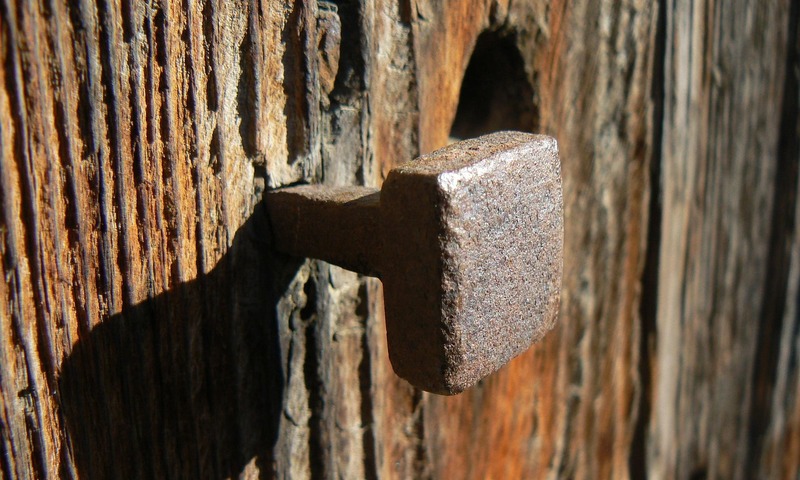This article was first published at . After it was published, the author of the Christianity Today article, Daniel Sulliman, posted an ; but the scholar behind it, Jeffrey Garc├şa, has not commented.
A recent article in Christianity Today titled has been raising some animated discussion on social media ÔÇô not surprising, since the opening sentence is ÔÇťThe Bible doesnÔÇÖt say Jesus was nailed to a cross.ÔÇŁ The article, written by Daniel Sulliman, is based mainly on an interview of Jeffrey P. Arroyo Garc├şa, a professor at Gordon College. Garc├şa also wrote an article on this topic, ÔÇť,ÔÇŁ published in Biblical Archeology Review.
HereÔÇÖs the thrust of Garc├şaÔÇÖs claims in the two articles. Early Roman accounts of crucifixions do not mention nails. The words related to crucifixion, in both Latin and Greek, do not necessarily imply nailing. The Latin verbs that are usually translated ÔÇťnailedÔÇŁ in those accounts mean ÔÇťattached,ÔÇŁ and do not specify how the victims were attached. The earliest accounts to mention nailing during crucifixions, Garc├şa says, are in Josephus. Josephus used the Greek verb ¤Ç¤ü╬┐¤â╬Ě╬╗¤î¤ë (▒Ŕ░¨┤ă▓§┼ž▒˘┤ă┼Ź), ÔÇťto nail,ÔÇŁ in some of his descriptions of crucifixions. From this, Garc├şa concludes that nailing during crucifixion was not likely widespread until the Jewish War (AD 66-70). Before then, victims were usually tied with ropes; they would still die from suffocation.
Now, Garc├şa says he is not certain of this interpretation of history. But he says that if his view is correct, then the Gospel of John is probably not historically correct when it describes Thomas saying ÔÇťunless I see the mark of the nails in his hands, and put my finger into the mark of the nailsÔÇŽ I will not believeÔÇŁ (John 20:25, 27). Here is Garc├şaÔÇÖs explanation:
John ÔÇťwas perhaps located in a region, such as Ephesus or elsewhere in Asia Minor, where nailing of the hands was well known.ÔÇŁ
ÔÇťJohn might be creatively weaving together these elementsÔÇŁ (from Luke 24:39).
ÔÇťthis account may have come from a time after the revolt or somewhere in the Diaspora where nailing was more common, while JohnÔÇÖs crucifixion story was adapted from his sources, likely the other Gospels.ÔÇŁ
ÔÇťthe point of the gospel passage, the Gordon professor points out, is that followers of the resurrected Christ shouldnÔÇÖt actually need nail holes to affirm their faith.ÔÇŁ
How does Garc├şa deal with other New Testament passages about nailing during crucifixion? In Luke, Jesus tells his disciples to look at his hands and feet (Luke 24:39). Garc├şa responds that this was to prove JesusÔÇÖ actual physical resurrection, not to show any wounds. Luke does not mention any nail holes.
Colossians 2:14 seems to describe nailing: God has canceled the ÔÇťcertificate of debt against usÔÇŽ having nailed it to the cross.ÔÇŁ Garc├şa responds (correctly, I think) that this passage uses the metaphor of a titulus, the criminal charges that are nailed to a cross (John 19:19-20), not a person who is nailed to a cross.
There are several problems with Garc├şaÔÇÖs claims. The most obvious is that the Bible indeed says that Jesus was crucified with nails. Thomas reasonably expected to see nail imprints on JesusÔÇÖ hands and feet, and Jesus showed them to Thomas: ÔÇťlook at my handsÔÇŁ (John 20:27). This scene is narrated in a gospel that claims to be based on an eyewitness account (John 19:35, 21:24). Garc├şaÔÇÖs suggestion that the point of the passage is that ÔÇťfollowers of the resurrected Christ shouldnÔÇÖt actually need nail holes to affirm their faithÔÇŁ misses the point. Thomas wanted to see the nail marks, and Jesus showed him the nail marks (John 20:25, 27). JesusÔÇÖ blessing on belief is for those who come later and therefore cannot see what Thomas could see (John 20:29). The blessing is predicated on the actual events of the account being true.
But there is no reason to question JohnÔÇÖs account of the nails in JesusÔÇÖ crucifixion, since we have adequate evidence of nails being used during the time of Christ and even earlier. Garc├şa acknowledges that JosephusÔÇÖ use of ¤Ç¤ü╬┐¤â╬Ě╬╗¤î¤ë (▒Ŕ░¨┤ă▓§┼ž▒˘┤ă┼Ź, ÔÇťto nail,ÔÇŁ) proves that nailing was used during the Jewish War in AD 66-70. But that term was also used in earlier descriptions of crucifixion. Philo, who lived at about the same time as Jesus (15 BC-AD 45), described crucifixion twice in metaphors: ÔÇťlike men crucified and nailed to treesÔÇŁ (߯Ľ╬╗╬▒╬╣¤é ¤Ç¤ü╬┐¤â߯Á╬╗¤ë╬Ż¤ä╬▒╬╣, Post. 62); ÔÇťnailed like crucified men to a treeÔÇŁ (¤Ç¤ü╬┐¤â╬Ě╬╗¤ë╬╝߯│╬Ż╬┐¤éÔÇŽ ¤äß┐Ě ╬żßŻ╗╬╗ß┐│, Dreams 2.213; see also Prov. II.24). The fact that Philo used these in metaphors meant that nailing during crucifixion was well known to his audience; no one would use a metaphor that their audience is incapable of understanding. Philo was also familiar with actual crucifixions, as he described in his denunciation of Flaccus, the Roman governor of Egypt (Against Flaccus 72, 83, 84). If Flaccus used nails during crucifixions when he was governor (AD 33-38), then it is not surprising that Pilate used nails when he was governor of nearby Judea (AD 26-36).
Evidence of nailing can be found even earlier than the first century AD. In the previous century, the historian Diodorus Siculus said that the Roman general Manius Pomponius Matho ÔÇťnailed Hannibal to the same crossÔÇŁ (╬Áß╝░¤é ¤ä߯Ş╬Ż ╬▒߯ɤä߯Ş╬Ż ¤â¤ä╬▒¤ů¤ü߯Ş╬Ż... ¤Ç¤ü╬┐¤â߯Á╬╗¤ë¤â╬Á╬Ż) that the Carthaginians had used to crucify a Roman commander (History 25.2). And the idea of nailing as part of executions was around even as far back as Herodotus (484-425 BC). He recounts that Xerxes ÔÇťnailed Artayctes to boards and hanged himÔÇŁ (¤Ç¤ü╬┐¤â¤Ç╬▒¤â¤â╬▒╬╗╬Á߯╗¤â╬▒╬Ż¤ä╬Á¤é ß╝Ç╬Ż╬Á╬║¤ü߯│╬╝╬▒¤â╬▒╬Ż, History 9.120).
How much does this matter? Clearly the nails are not central to our belief in the death and resurrection of Jesus. But the claim that nails were not commonly used in crucifixions before AD 66 can be decisively refuted, so it should not be used to question the historicity of JohnÔÇÖs account. Thomas did indeed see nail imprints in the hands of the resurrected Jesus.
 ║┌┴¤└˙╩Ě
║┌┴¤└˙╩Ě


.jpg)

